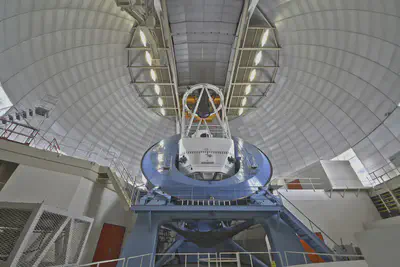Collaborations
Over the last couple of decades, observational cosmology has become a field dominated by large international collaborations, with hundreds (if not thousands) of scientists working together to carry out complex analysis of huge datasets. The study of the Lyman alpha forest is not an exception.
The first measurements of the clustering of matter from the Lyman alpha forest appeared at the turn of the millennium, and were limited to the 10 or 20 spectra of high-redshift quasars available at the time (Croft et al. 1999, McDonald et al. 2000). The situation changed dramatically in the year 2000 with the start of the Sloan Digital Sky Survey (SDSS), a dedicated telescope in New Mexico that would map the sky in the search of galaxies and distant quasars. Within five years, SDSS obtained the spectra of over 16,000 quasars that could be used for studies of the Lyman alpha forest (McDonald et al. 2006). With SDSS, quasars lost their name and got a serial number instead.

In 2009 started the Baryon Oscillation Spectroscopic Survey (BOSS), a five-year campaign to study the expansion of the Universe across cosmic time using the technique of Baryon Acoustic Oscillations (BAO). BOSS used a new instrument in the SDSS telescope to multiply by a factor of ten the number of quasar spectra for studies of the Lyman alpha forest (Bautista et al. 2017). In 2014 started the extended BOSS (eBOSS), that used the same instrument for five more years to increase the number of available quasar spectra to 21,000. Presented in 2020, the final measurements from eBOSS became the state of the art in terms of studies of the Lyman alpha forest (du Mas des Bourboux et al. 2020) and studies of the expansion of the Universe (eBOSS Collaboration 2021).

Now it is the time of the Dark Energy Spectroscopic Instrument (DESI), that in May 2021 started a five-year campaign to revolutionize the study of the expansion of the Universe. Soon after DESI became the largest spectroscopic survey to date, and by 2026 we expect to have obtained the spectra of more than 800,000 Lyman alpha quasars. Cosmo-Lya is co-leading the first measurements of 3D correlations in the Lyman alpha forest using early data from DESI, while coordinating the analysis of the Year 1 dataset that will be published in 2024.